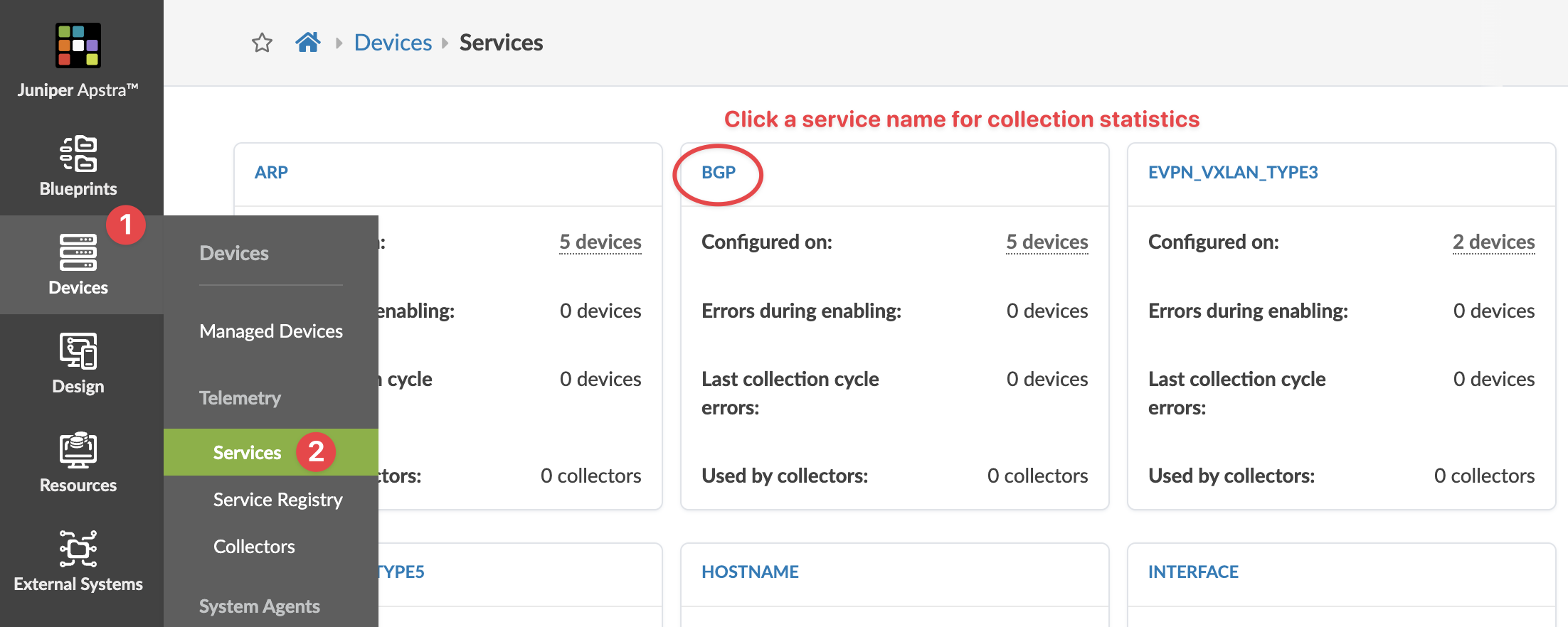All Telemetry Services
From the left navigation menu of the Apstra GUI, navigate to Devices > Telemetry > Services to go to a summary of telemetry services.

Telemetry services include the following:
| Service | Description |
|---|---|
| ARP | ARP telemetry shows an ARP table. You can query this information via API. Anomalies are not generated. |
| BGP | BGP telemetry shows role(s), VRF name, address family, source and destination information, expected and actual states, intent status, last fetched/modified, and BGP peer state. |
| Config |
This is the running config. Devices with deviations between the rendered discovered/service config and the actual config are flagged with a config deviation error. When configuration changes are made outside of Apstra management, alarms are generated immediately. The risk with a configuration deviation is that it is possible for Apstra to overwrite the deviated configuration with a configuration re-write. The correct way to deal with a config deviation alarm is to understand the configuration change being made, and consider setting it up as a configlet instead. |
| Counters | Counter telemetry provides information about interface in/out packets, interface errors, statistics, and so on. This feature is consumed by other advanced downstream features like telemetry streaming. No anomalies are generated. |
| Hostname | When you assign a device with deploy mode Ready to a blueprint, the device enters the Ready stage (previously known as Discovery 2). Hostname telemetry is collected that validates the device hostname against intent. Mismatches result in anomalies. |
| Interface | When you assign a device with deploy mode Ready to a blueprint, the device enters the Ready stage (previously known as Discovery 2). Interface telemetry is collected that compares intent with the up/down state of physical interfaces. It does not include LLDP, LAG or any other attachment information. |
| LAG | LAG telemetry shows the health of all the LACP bonds facing servers and between MLAG switches. |
| LLDP (Cabling) | When you assign a device with deploy mode Ready to a blueprint, the device enters the Ready stage (previously known as Discovery 2). Every node is part of intent. On each link, there are expected neighbor hostnames, interfaces and connections. Physical cabling and links must match the specified intent. Any deviations result in anomalies that you must correct by either recabling to match the blueprint or by modifying the blueprint to match cabling already in place. |
| MAC | MAC Address-table telemetry shows which MAC addresses appear on which interfaces, and which VLANs. |
| MLAG |
MLAG telemetry tracks the health status of the MLAG domain itself - the control-protocols required between two leaf switches communicating with each other properly for the MLAG domain state. Implementation detail differences exist between multiple vendors, but the intent is the same -the switches should be healthy among each other. MLAG telemetry is only available for L2 blueprints that have at least one virtual network assigned in an MLAG pair. If an MLAG-attached server is not fully connected, the state changes from ‘active_full’ to ‘active_partial’. Note:
Cisco MLAG (VPC) commands cannot derive the status of the LAG on the VPC peer switch. Accordingly, the state dual-active cannot actually gather the command. This is a limitation from Cisco. |
| Route | Routing telemetry analyzes the routing table on every managed spine and leaf. Since the entire IP fabric is managed, you can derive and predict full IP table information from the network topology. Deviations in the network routing telemetry (for example, a missing next-hop IP address for a default route) cause an alarm. |
| Transceivers | Transceiver telemetry gives the network operator statistics on optical interfaces, showing DOM statistics, light levels, lossy interfaces, and other optical statistics. No anomalies are generated. |
| Utilization (Onbox agents only) |
Utilization telemetry allows the network operator to view some vital statistics on the device - CPU and Memory utilization. No anomalies are generated. Utilization telemetry is not available on devices using offbox agents (Junos for example). Therefore, the utilization tab contains the error Network Device not found. |
